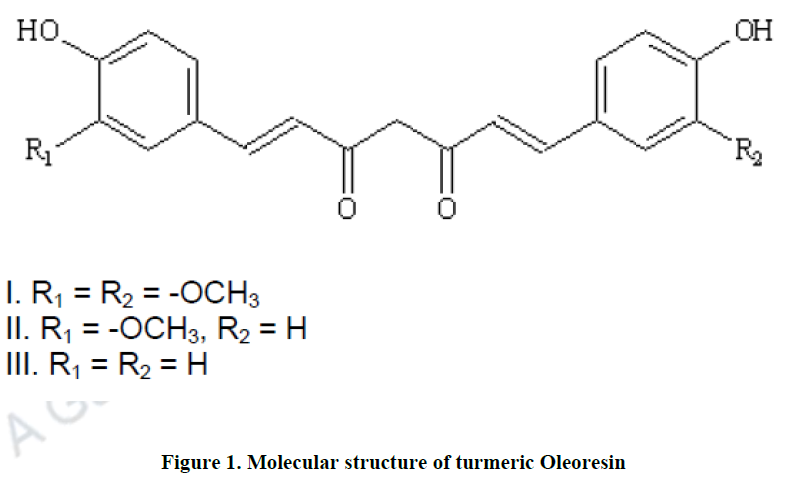30 Turmeric: Essential oil and oleoresin
30.1 Introduction
Turmeric, have traditionally been used as a source of coloring matter for foods, cosmetics and textiles and as a medicinal ingredient of formulations of the Indian system of medicine for several common ailments. Turmeric is an underground storage organ that is rich in secondary metabolites, many of which have been identified and characterized, while newer ones are expected to be discovered. Turmeric powder, extracts and oleoresins are some of the widely used commercial products of the C. longa plant. The essential oils and the diarylheptanoid curcumin, which are the major secondary metabolites of turmeric, have been shown to be largely responsible for the pharmacological activities of turmeric powder, extracts and oleoresins. The main activities have been found to be anti-inflammatory; hepatoprotective, anti-microbial, wound healing, anticancer, anti- tumor and anti-viral. The volatile oil of turmeric has been shown to possess anti-inflammatory activity and to increase bile flow. Both curcumin and the volatile oil have been shown to possess wound- healing properties and inhibitory activities against pathogenic fungi, both in vitro and in– vivo.
Since curcumin is the compound of interest in turmeric rhizome, it is important to know the solubility of curcumin in different solvents in order to choose the appropriate solvent. Curcumin is soluble in polar solvents (acetone, ethyl acetate, methanol, ethanol), and quite insoluble in non-polar solvents such as hexane, and insoluble in water. The oil composition of C. longa from various parts of the world has been studied extensively. The leaf oil of C. longa from Vietnam contained mainly α- phellandrene (24.5%), 1,8- cineole (15.9%), p-cymene (13.2%) and β-pinene (8.9%) ,while that of a Nigerian chemotype contained mainly α-phellandrene (47.7%) and terpinolene (28.9%). The rhizome oil of C. longa from northern plains of India was reported to contain 59.7% of ar-turmerone while the rhizome oil of another Indian chemotype was characterized by ar-turmerone (41.4%), turmerone (29.5%) and turmerol (20%).
30.2 Oleoresin
If the oleoresin is the desired product, the solvent is completely evaporated by distillation at 45-55 °C. If curcumin is the final product, the solvent is only partially removed, and the color material is separated from the solvent by freezing, then centrifugation or vacuum-filtration. At this step, curcumin is further purified with a wash with hexane. Hexane will extract all the gummy matter, oils, fats, and volatile essential oils that would otherwise impart a turmeric flavor. The yield of curcumin from dried turmeric root is about 5%. Oleoresin composition will vary greatly with the type of solvent, temperature and extraction methods, in addition to the effect due to quality of the raw material. The commercial methods of extraction will vary by manufacturer and are proprietary information. The yield of oleoresin from dried root is typically 10-12%.
30.3 Structure of turmeric oleoresin
The selection of a turmeric oleoresin of a particular composition is based on the intended use in food. In general, all turmeric oleoresins contain coloring matter and most contain flavoring matter but some oleoresins are processed to remove aromatic compounds. Commercial products include oleoresins (per se) and formulations in which oleoresin is diluted in carrier solvents and which may contain emulsifiers and antioxidants. Purified extracts of turmeric containing more than 90% total coloring matter are subject to specifications for “Curcumin”. Turmeric Oleoresins are sold on the basis of “color value” or “curcumin content”, which generally means the total content of the curcuminoids substances: (I) curcumin, (II) demethoxy curcumin and (III) bis-demethoxy curcumin. The principle colouring components of turmeric oleoresin:
- 1,7-Bis(4-hydroxy-3-methoxyphenyl)hepta-1,6-diene- 3,5-dione.
- 1-(4-Hydroxyphenyl)-7-(4-hydroxy-3-methoxyphenyl)-hepta-1,6-diene-3,5-dione.
- 1,7-bis(4-hydroxyphenyl)hepta-1,6-diene-3,5-dione.
India is a leading producer of turmeric in the world. Andhra Pradesh and Tamil Nadu are the leading producers followed by Kerala, Karnataka, Bihar and Maharashtra. There are several applications of turmeric and it is used in many food and snack preparations, as offerings in ceremonies, in pharmaceutical and cosmetic production, to extract one type of starch and even the by- products obtained during its polishing are used as manure and for making incense sticks. Thus, it is a versatile product with demand round the year across the country. Some of the important Indian varieties and their essential oil %age is as shown in table below:
| you can view video on Turmeric: Essential oil & Oleoresins |


